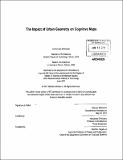| dc.contributor.advisor | Alexander D'Hooghe. | en_US |
| dc.contributor.author | Mohsenin, Mahsan (SeyedehMahsan) | en_US |
| dc.contributor.other | Massachusetts Institute of Technology. Dept. of Architecture. | en_US |
| dc.date.accessioned | 2011-09-13T17:45:57Z | |
| dc.date.available | 2011-09-13T17:45:57Z | |
| dc.date.copyright | 2011 | en_US |
| dc.date.issued | 2011 | en_US |
| dc.identifier.uri | http://hdl.handle.net/1721.1/65743 | |
| dc.description | Thesis (S.M.)--Massachusetts Institute of Technology, Dept. of Architecture, 2011. | en_US |
| dc.description | Cataloged from PDF version of thesis. | en_US |
| dc.description | Includes bibliographical references (p. 86-87). | en_US |
| dc.description.abstract | This thesis investigates the relationship between urban geometry and cognitive maps. It is focused on the question of how human cognition of the built environment is affected by urban geometry. Building on the foundations of Kevin Lynch's studies of environmental perception (Lynch, 1960) and recent configurational measurement techniques of the built environment, it addresses an important question that Lynch has left unresolved: Why do people have more complete recollections of some parts of the urban environment, and not others? This thesis proposes an analytical measurement framework based on graph theory to compare the results of cognitive maps with objective spatial properties of the corresponding built environment. In order to test our hypothesis, first I measure and define urban geometry based on graph theory in two selected areas with different geometries in Kenmore, Boston and Kendall Sq., Cambridge, MA I will then collect cognitive maps based on specifically designed map drawing surveys. Finally, I examine the relationship between graph results and cognitive maps in order to identify the ways that urban geometry affects human perception. The findings inform urban designers and scholars of the city of how the configuration of the built environment can affect people's memory of a place, thus shaping one's experience of a city. Keywords: configurational patterns, urban geometry, cognitive maps, graph theory. | en_US |
| dc.description.statementofresponsibility | by Mahsan Mohsenin. | en_US |
| dc.format.extent | 91 p. | en_US |
| dc.language.iso | eng | en_US |
| dc.publisher | Massachusetts Institute of Technology | en_US |
| dc.rights | M.I.T. theses are protected by
copyright. They may be viewed from this source for any purpose, but
reproduction or distribution in any format is prohibited without written
permission. See provided URL for inquiries about permission. | en_US |
| dc.rights.uri | http://dspace.mit.edu/handle/1721.1/7582 | en_US |
| dc.subject | Architecture. | en_US |
| dc.title | The impact of urban geometry on cognitive maps | en_US |
| dc.type | Thesis | en_US |
| dc.description.degree | S.M. | en_US |
| dc.contributor.department | Massachusetts Institute of Technology. Department of Architecture | |
| dc.identifier.oclc | 748856415 | en_US |
